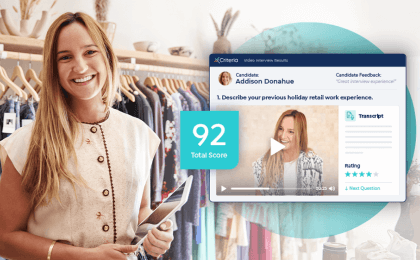Interviews have quite the reputation as make-or-break-moments in the hiring process. But if you’re interviewing candidates correctly, you’ve probably learned that there’s so much more to this meeting than just asking a prospect to tell you about themselves.
Whether you’re getting to know candidates face-to-face, over the phone, asynchronously or synchronously via video interviews, there are best practices to ensure you conduct the fairest, job-relevant, and most fulfilling interview possible. Here are nine of the most crucial do’s and don'ts of interviewing:
1. DO Establish a Friendly Rapport
Whether you’re screening a candidate for an entry-level position or searching for your next C-level executive, a warm and friendly introduction should almost always be first on your to-do list when conducting an interview. After all, they’re not the only person who’s making an impression today.
Remember to say hello, smile and shake the applicant’s hand. Offer a few niceties, whether that’s asking them if they found the office okay or commenting on how rainy it’s been. Ice breakers really do warm up a dialogue, and that’s a major win, especially if you’re interviewing somebody who happens to be a bit shy. (Remember, a quiet or reserved candidate may very well be the best candidate for the job!)
2. DON’T “Wing It”
Work is hectic, especially for human resources professionals and hiring managers. It can be tempting to do little to no preparation prior to meeting a prospective employee.
If you are able to spend even ten or fifteen minutes preparing for every interview you conduct, then you are likely to reap the benefits both now and later. More prepared interviewers ask more meaningful questions, unlocking more revealing answers. The more prepared you are, and the more structured the interview questions, the better. More on that soon!
Better-prepared interviewers also waste less time re-reviewing resumes, which allocates more time to answering important questions your interviewee may have. These questions are ultra-important and can save you time, money, and hassle later, especially if they help a candidate better understand the ins and outs of a position they may soon fill.
3. DO Share Your Game Plan
Since your goal as an interviewer is to try to assess whether a candidate is right for a job opening, you’ll want to do everything in your power to set them up for success. Not every applicant who walks through the doors of your office is going to be naturally charismatic and a great conversationalist. And the most charming and chatty prospects are not always the best fit. By revealing upfront how you plan to conduct an interview, you give all interviewees a more level playing field by reducing nerves and eliminating surprises.
After introducing yourself to an applicant, tell them how you have structured the interview and what your objectives are for the meeting. You might want to say that you are going to review their resume together, then ask a couple questions about their past experiences and future aspirations, then spend some time explaining the job and company culture, and then finally answer any questions they may have.
4. DON’T Surprise Candidates
If you plan to ask candidates to take a test or assessment, meet with a wide variety of people, or attend an all-day interview, let them know well in advance. While you may expect a candidate to block off an entire day to come in and meet you, it’s not always possible without advanced notice. If your candidate needs childcare, utilizes public transportation, or reports to an inflexible manager at a current position, you may put undue stress on them by surprising them with an interview that exceeds the standard hour or so.
Since you want your hiring process to be as fair and unbiased as possible, try to be upfront about lengthy interview processes. Work around your prospects’ different and diverse schedules. While it may seem easier to prefer applicants who have all-day availability and infinite time to chat, keep in mind that these qualities tend to be indicative of privilege, not work ethic, motivation, or future performance.
Making an effort to level the playing field during the interview stage will help you create a more diverse and dynamic workplace. One possibility to create a more equitable interview process that meets the flexibility requirements of diverse schedules is to implement video interviewing software. Once implemented, video interviewing tools provide applicants with a time-independent opportunity to participate in your hiring process while improving fairness in questions and evaluations among all candidates.
5. DO Conduct a Structured Interview
There are two common types of interviews: structured and unstructured. In an unstructured interview, there are no defined questions, and the whole meeting feels a lot more like a loose conversation about a job opportunity than a formal meeting. Unstructured interviews are notoriously biased, favoring candidates who have chemistry or shared interests with the interviewer. Unstructured interviews are also a notably poor way to gauge future job performance.
A structured interview, which does require more work upfront, is a better bet. Structured interviews rely on a defined, standardized set of questions that help clarify if the candidate is qualified for a given employment opportunity. That means that someone who went to your alma mater will be asked the same questions as everyone else who earns an interview. Moreover, structured interviews utilize behaviorally anchored rating scales (BARS), a fancy term for an evaluation rubric, to investigate candidate performance while leveling the playing field by reducing rater bias (Kell et al., 2017).
While that may seem less colorful, it’s worth it. Research shows that structured interviews are 1.6 times more predictive of job performance as unstructured interviews.
6. DON’T “Trust Your Gut”
Since we were kids, we’ve been told to trust our gut, follow our instincts and listen to our first impressions. While this sage advice tends to serve us in friendship, romance, and even restaurant selection, it’s not so applicable to hiring decisions.
There’s nothing wrong with taking a liking to a certain applicant, and there’s nothing wrong with giving them some bonus points for affability, either. But fun and friendly are probably not requirements for a job well done at your workplace. If a fair and thorough hiring process is your company’s mission, you should try to throw away your “first impression” when interviewing a candidate.
If utilizing asynchronous video interviews as part of the selection process, another helpful technique is to participate in blind hiring to limit the impact of stereotyping and other biases. This method of revision removes certain candidate identifiers which reduces areas of an interview prone to bias. Taking a more objective approach to interviewing improves the likelihood that interviewers will consider each applicant by looking at the whole person. Not just their interview, but their resume, their pre-employment testing results, and anything else your company considers when making hiring decisions.
7. DO Invest in Pre-Employment Testing
Even the best interviewers admit that interviewing is inherently subjective. To make your interviews fairer, conduct structured interviews and offer pre-employment testing, which can make your hiring process more efficient, increase legal defensibility, boost employee retention and supercharge productivity.
How, exactly? Top-notch pre-employment testing has been carefully designed to gather meaningful data about candidates--information that’s usually not discernible during a traditional interview. There are many different types of pre-employment testing, but almost all assessments fall into three categories: aptitude, personality, and skills tests.
Aptitude tests measure qualities like critical thinking, problem solving and the ability to learn and apply new information. These tests are some of the best predictors of job performance. There are also personality tests, which measure behavioral traits and person-job fit. These tests can help you decide whether a person’s behavioral tendencies are a good match for an open position. Finally, there are skills tests, which measure job-related competencies like typing, coding, and other hard skills.
Most hiring professionals use a combination of pre-employment testing as part of their hiring repertoire. These standardized, objective tests offer black-and-white data when so much other information about a candidate is nuanced and subjective.
8. DON’T Leave a Bad Impression
It’s a job seekers’ market, and there are more good positions available than there are top-notch candidates to fill them. Chances are that your applicants are going through the motions with several of your competitors, too. To a candidate, you are the face of your company. That means that warmth, respect, and transparency go a long way.
While you should be making every effort to give your candidates the benefit of the doubt, those you interview will not always do you the same courtesy. The first impression you make will matter and will serve as a reflection of your company’s culture, too.
That being said, try to be open and honest with prospects whenever possible. Explain to them how your hiring process works, establish transparency early on to avoid surprising them, and let them know how long it usually takes for your team to make a decision. Be kind, always. Thank them for their time. If you choose not to hire them, follow up in a timely fashion.
9. DO Compare Candidates
You should take notes during interviews. Putting pen to paper right away is crucial because after a long few weeks of interviewing, your recall will be imperfect. If your memory fails you, you will probably remember only which candidates you liked best, which is not the same as choosing the candidate who could best perform in a given role.
You may want to use an evaluation form or another standardized method to help keep your feedback fair and on-track. This is standard practice when conducting structured interviews.
When you’ve finished assessing candidates, use data from across the board (like pre-employment testing results and interview notes) to compare applicants. Hopefully, you’ll be able to make a fair, informed hiring decision that will lead you to the best possible person for the job.





